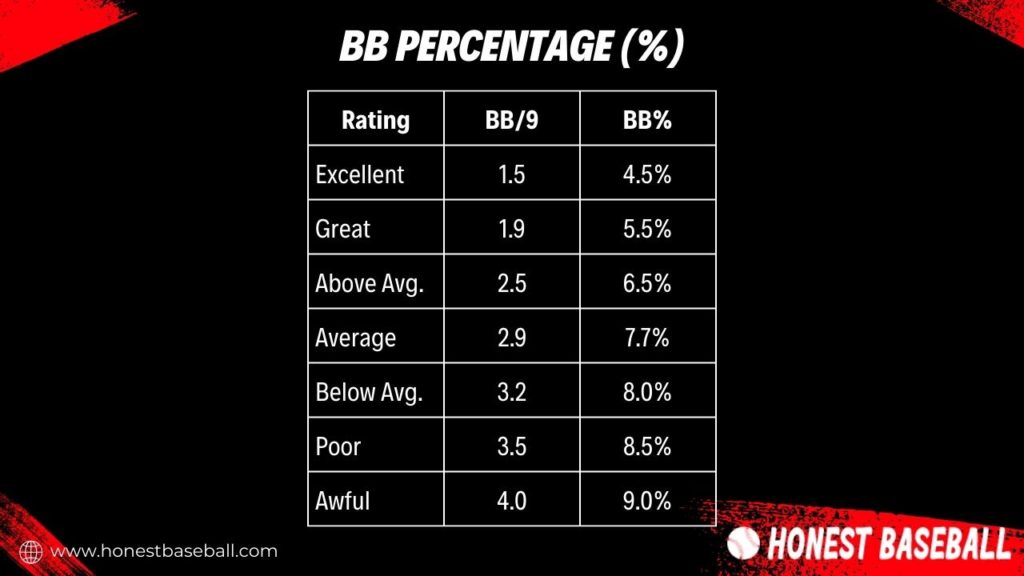You might be wondering what does BB mean in baseball scores while watching a game. The abbreviation BB stands for “base on balls” and is a key baseball scoring term that every fan should understand.
When analyzing baseball statistics or scores, you’ll see BB used to denote a batter being awarded first base after drawing a walk.
It won’t be easy to understand for you without knowing the complete mechanics and rules. This includes how many balls lead to a BB, its impact on batting statistics, etc.
Without that, having an idea about the star players who mastered BB, you can feel the 100+ years of legacy of the term. Let’s dig into this.
Key Takeaways
- BB baseball meaning is referred to as a scoring shorthand for a walk.
- Drawing walks positively impacts on-base percentage while not affecting the batting average.
- Pitchers can intentionally walk batters without throwing pitches, strategically putting runners on base. Managers use this tactic judiciously.
- Unlike a hit by pitch, a walk or BB keeps the ball live, allowing runners to steal bases and advance past where forced. This encourages aggressive baserunning.
- All-time great power hitters like Barry Bonds and Babe Ruth also excelled at coaxing walks, pocketing 2,558 and 2,062 BB respectively.
- In recent MLB seasons (2020-2022), pitchers have demonstrated improved command, lowering walk rates. Decreased walks lead to more unpredictability and excitement.
What Does BB Mean in Baseball Slang?
As mentioned earlier, in the lingo of baseball scoring and statistics, the abbreviation BB stands for “base on balls.” It’s also more commonly known as a walk.
This occurs when the pitcher throws four pitches that are outside of the strike zone. It’s delineated by the umpire and the batter refrains from swinging at them.
A walk is considered an important statistic in baseball as it reflects both the:
- Level of control of the pitcher.
- And batter’s ability to discern balls from strikes.
The high number of walks allowed by a pitcher generally indicates:
- Issues with command of pitches.
- An inability to consistently throw strikes.
On the flip side, batters who draw a lot of walks demonstrate the:
- Skill to lay off pitches outside the zone.
- Often shows they have a good sense of the strike zone.
BB Is Also Called a Walk in Baseball
The terms “base on balls” (BB) and “walk” are interchangeable in the sport of baseball.
They both refer to the scenario when a batter is awarded first base automatically (by the umpire) after the pitcher throws 4 pitches deemed to be balls outside of the strike zone.
“Walk” is the more frequently used term. And “Base on Balls” appears as the abbreviation in baseball box scores and statistical records.
“But both ultimately represent the same outcome – the batter heads to first base without putting the ball in play by virtue of the pitcher’s lack of control.”
So despite the two different phrasings, “BB” and “walk” indicate the exact same notation in the game of baseball.
Here are a few important points you should know about BB rules in baseball:
Number of Balls Until Getting a BB
In order for a batter to draw a walk in baseball and be awarded first base automatically,
- The pitcher must throw 4 balls outside of the strike zone.
- Each pitch that fails to cross into the strike zone as determined by the umpire is ruled a ball.
- After 3 balls, the next pitch that misses the zone results in a walk.
So in essence, a batter must receive four judged balls by the umpire without swinging the bat to earn a baseball BB.
Displaying the discipline to refrain from chasing pitches out of the zone is an invaluable skill for hitters in baseball.
It can force the pitcher to narrow their strike zone leading to more hittable pitches.
The more walks a batter draws, the higher their on-base percentage, which is crucial for generating offense.
Number of Intentional BB Allowed in a Game
In the 2023 official rulebook of Major League Baseball, there’s no limit imposed on the number of intentional walks that a team can issue over the course of a regulation game. Also:
- The manager and pitching coach have the discretion to call for an intentional walk.
- They can do it as frequently as they deem necessary based on the game situation and matchups.
Hypothetically that means, a team can choose to intentionally walk every single batter it faces in a game if that’s their desired strategy.
Now in practice, this rarely occurs since intentionally conceding that many runners on base is likely to lead to giving up a lot of runs.
But the flexibility does exist in the framework of the rules.
A Hitter Can’t Refuse a BB
In the sport of baseball, when a batter receives ball four from the pitcher (resulting in a walk,) they are required to go to first base and
- Aren’t permitted to decline or refuse the base on balls.
- The decision of whether or not to swing at a pitch lies entirely with the batter.
- But once the umpire has signaled a walk, the batter must take their base without exception.
Refusing a walk would constitute interference on the part of the batter and a violation of the rules of play.
“If a pitcher loses command and throws four clear balls out of the strike zone, the batting team rightfully deserves to have a runner on first base as a consequence.”
The notion of refusing a walk undermines the competitiveness of the game.
A Runner Can’t Steal the Base on a BB
When a batter draws a walk and is awarded first base automatically, the ball is considered dead at that point.
- And runners on base are unable to attempt to steal the next base up.
“The rationale behind this rule is that the batter has already earned the right to first base without any fielding action occurring.”
- In addition, note this, the pitched balls are all deemed to be out of the strike zone.
- So, there’s no legitimate chance for the catcher to throw out potential base stealers in that situation.
- Therefore, the catcher is prohibited from making a throw down to second or third base following ball four that seals a walk for the batter.
The runner or runners can only advance when they are forced to by the batter proceeding to first base on the walk.
A BB Doesn’t Affect the Batting Average
In baseball, a batter’s BB (walks) don’t count as official at-bats. Hence, a BB doesn’t negatively or positively affect a player’s batting average.
“Batting average is calculated by dividing the number of base hits a player has by their total at-bats over a given period. Since a walk doesn’t result in either a hit or an out, it’s not included in the batting average computation.”
For example,
- If a batter has 10 hits in 30 official at-bats, their batting average would be .333.
- If they then draw a walk in their next plate appearance, their batting average remains .333 because that plate appearance isn’t counted as an at-bat.
- It’s because the batter reached base safely but didn’t actually record an at-bat when drawing the base on balls.
This demonstrates how batting average purely measures a batter’s ability to record hits safely.
And it’s not swayed by walks, hit by pitches, sacrifices, or errors that also result in the batter reaching base.
So, players need not worry about walks dragging down or inflating their batting average over a season.
BB Isn’t Counted as an At-Bat or Hit
When a batter draws a BB, it doesn’t count as an official at-bat or as a hit.
At-bats and hits strictly pertain to instances where the batter reaches base safely following a batted fair ball without interference by the defense.
Because a base on balls doesn’t require the batter to even swing the bat, let alone record a hit, it can’t be counted in the batter’s at-bat or hit totals. That’s how BB stands in the MLB records or statistics.
To understand it with an example, let’s assume;
- A player finishes a game going 0-3 officially but draws 2 walks in their other plate appearances.
- So, their hit and at-bat count would remain 0-3 disregarding the walks.
“Walks still provide value by allowing a batter to reach base without utilizing finite hit opportunities. But categorically, walks are set apart from at-bats and hits in baseball scoring.”
You Can Walk the Batter without Pitching
The defensive team has the option of intentionally walking a batter without having to throw any pitches.
This strategic move can be made by the manager sending out a signal from the dugout. He can request the umpire to immediately award the batter first base.
Here are some key points on intentionally walking a batter without pitching:
- It automatically awards first base to the batter without wasting pitches.
- The defense uses it to bypass power hitters or set up potential double plays.
- The ball is dead and runners cannot advance unless forced.
- There are no limits on using this strategy during a game.
- Pitch selection data reflects four automatic balls instead of actual pitches.
- It can disrupt a batter’s rhythm and comfort at the plate.
This loophole allows teams to intentionally put runners on base during key situations to gain a tactical advantage.
For instance, it can be getting a force out at another base while avoiding challenging hitters.
BB in Baseball History
Throughout the history of baseball, the phenomenon of the base on balls (BB) as represented by the common term “walk” has been an integral element of the game’s strategy and statistics:
- In the late 1800s, legendary manager Cap Anson emphasized the value of the walk and on-base percentage as a precursor to modern analytics.
- Hall of Famer Babe Ruth revolutionized offense in the 1920s by combining massive power with a keen eye to draw walks at a historic rate.
- Ted Williams famously advocated for a disciplined, patient approach of only swinging at strikes to draw walks.
- Barry Bonds broke the all-time single-season walks record with 232 free passes during the 2004 season.
- In recent decades, on-base percentage and walks have become cornerstones of Moneyball tactics aimed at efficient and high-scoring offense.
- Modern immortals like Joey Votto, Mike Trout, and Bryce Harper have carried on the mastery of the strike zone evidenced by gaudy walk totals.
The walk and on-base skills it demonstrates remain a fundamental indicator of offensive aptitude over 150+ years of baseball history and counting.
Mastering when not to swing may be as vital as learning when to swing for aspiring hitters.
BB vs. Hit By Pitch (HBP)
There are important distinctions in the effect on play between a batter being walked (BB) and being hit by pitch (HBP) in baseball:
- BB (Walk) – The ball remains live on a walk. Baserunners can freely attempt to advance extra bases beyond where they are forced.
- HBP (Hit By Pitch) – The ball is ruled dead on a hit by pitch. Baserunners must return to their previous base and cannot advance further in the play.
| Difference | BB (Walk) | HBP (Hit By Pitch) |
| Effect on ball | Live ball | Dead ball |
| Baserunner advancement | Allowed to attempt to advance extra bases | Must return to the previous base |
| Strategic reasoning | Encourages baserunning aggression | Prevents defensive advantage from hitting batters |
| Pitcher accountable | Yes, for allowing walk | No, the pitch hit the batter |
| Baserunner stealing | Allowed | Not allowed |
| Pitch counted | Yes, as 4 balls | No |
| Affects the batter’s stats | No effect on AVG/AB increases OBP | No effect on AVG/AB increases OBP |
BB or Base on Balls Impacts Batter’s Statistics and Performance
While a walk doesn’t register as an at-bat or hit on a batter’s stat line, it still holds important statistical and performance value:
- It positively contributes to a batter’s on-base percentage.
- Hitters who draw a lot of walks tend to see more pitches and get deeper into counts, tiring out pitchers.
- A high walk rate demonstrates a batter’s excellent knowledge of the strike zone and pitch recognition.
- Walks allow you to reach base without risking making an out on batted balls in play.
- Baserunners generated via walks create offensive pressure and run-scoring chances.
- Working out walks indicates maturity, and patience and forces pitchers to attack the strike zone more aggressively.
- Pitchers may alter their entire game plan based on a hitter’s walk rate and avoidance of pitching around them.
While not as flashy as hits, walks are a foundational offensive skill for hitters that wise players can’t overlook when evaluating performance.
A Good BB% Percentage
There’s no definite rulebook for measuring good or bad based on ball percentage. Besides, the ratio changes every year. As a general, you can count on the below as it’s used as a reference by Fangraph.

Rating: Excellent
- BB/9 (1.5): Indicates exceptional command. Very few walks are allowed.
- BB% (4.5%): Extremely low percentage of batters walked. Forces contact.
Rating: Great
- BB/9 (1.9): Still considered top-tier control. Very few free passes were given up.
- BB% (5.5%): Walks only a small fraction of batters faced. Works ahead in counts.
Rating: Above Average
- BB/9 (2.5): Better than MLB’s average walk rate. Doesn’t allow many walks.
- BB% (6.5%): Limits walks well compared to peers. Throws a lot of strikes.
Rating: Average
- BB/9 (2.9): Around league average walks. Decent but room for improvement.
- BB% (7.7%): Typical MLB starter walk rate. Not great but not terrible either.
Rating: Below Average
- BB/9 (3.2): Walks are starting to become a concern. Losing some command.
- BB% (8.0%): Issuing too many unnecessary free passes. Needs better control.
Rating: Poor
- BB/9 (3.5): Control issues lead to too many walks. Frequently falls behind.
- BB% (8.5%): Loses the zone too much. Allows runners on base often.
Rating: Awful
- BB/9 (4.0): Serious command problems. Walks batters at a very high rate.
- BB% (9.0%): An extremely high percentage of batters walked. Cannot find the zone.
Baseball Players with the Highest BB Scores

Throughout baseball history, certain hitters have stood out for their uncanny knack for coaxing walks at an extraordinarily high rate. These five players posted some of the loftiest BB scores of all time:
- Barry Bonds – The all-time record holder with 232 walks in 2004 and over 2,558 career walks. His approach essentially weaponized walks.
- Babe Ruth – In the 1920s, he popularized the term “walk” and blended walks with power-hitting. Had eight seasons over 150 walks. Moreover, he had 2,062 BB in his whole career.
- Ted Williams – Set the benchmark for modern plate discipline. Led the league in walks eight times with a career 20.7% walk rate. With 2,021 bases on balls, Ted ranks as 3rd highest BB scorer.
- Joe Morgan – The undersized second baseman walked over 100 times in a season five times thanks to his keen batting eye. He scored a total of 1,865 bases on balls in his professional baseball career.
- Mickey Mantle – His career 17.5% walk rate was unheard of for a power hitter. Excelled at waiting for the right pitch to hammer. Mickey scored a total of 1,733 BB during his career.
These hitters helped transform the simple walk into both an art form demonstrating plate discipline and another tool to create offensive havoc. Their mastery of the strike zone led to historic BB totals.
Recent BB or Walk Trends in MLB
Several fascinating trends have emerged in the past decade regarding batters drawing walks (BB) across Major League Baseball:
MLB average walk percentage decreasing over recent seasons:
- Fell from 8.8% in 2021 to 8.5% in 2022
- Also declined from 9.1% in 2020
Factors contributing to this downward trend:
- Pitching coaches emphasize command and control even if velocity must be sacrificed
- Teams using analytics showing walks strongly predict pitching success leading to a focus on reducing walk rates
- Increased use of offspeed and breaking pitches, making it harder for batters to hit and lay off
Star pitchers with very low recent walk rates:
- Corbin Burnes: 5.7% in 2021 and 2022
- Gerrit Cole: 5.9% in 2021
- Robbie Ray: 5.7% in 2021
“Corbin Burnes won the Cy Young Award in 2021, and Gerrit Cole and Robbie Ray were both Cy Young finalists.”
Top pitchers succeeding shows trend indicates pitchers are becoming more efficient and effective
The declining walk rate is positive for MLB overall. Because it makes games more exciting and unpredictable. Also, that trend is surely increasing pitcher value.
Wrapping Up
So, that’s all I had to share to clarify what does BB mean in baseball. Whether you call it a BB, base on balls, or walks, it does have impacts on baseball scores and sometimes on players’ performance.
For both hitters and pitchers alike, the simple walk is anything but an insignificant part of baseball.
Check out more baseball slangs:
What Does BP Mean in Baseball?

Hello everyone. My name is Jason Butler, and I live in California, America. I was a professional AAA Minor League Baseball player. I lost my chance of playing MLB for injury issues, but I did not lose my love for baseball. I attended the coaching training program and am now working as a coach in a small school in San Diego.
I always love to share my experience and knowledge if that can help you. Play baseball, and stay fit.
